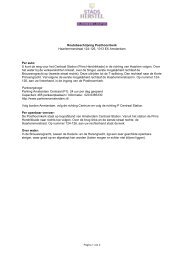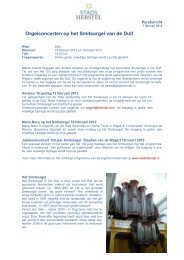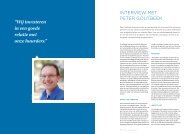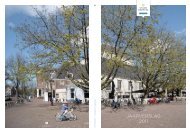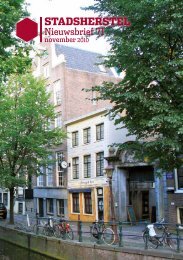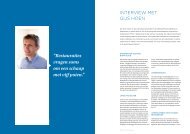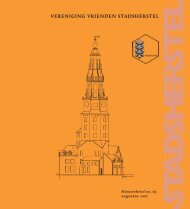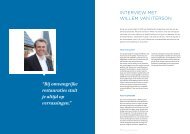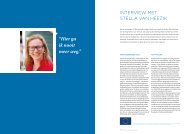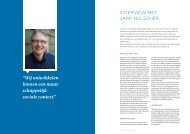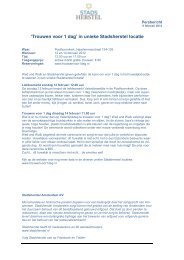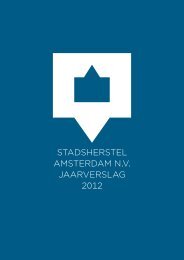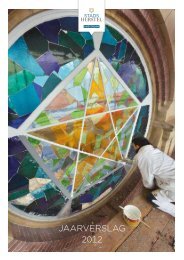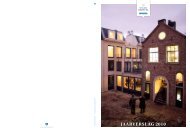StadSherStel amSterdam
StadSherStel amSterdam
StadSherStel amSterdam
- No tags were found...
Create successful ePaper yourself
Turn your PDF publications into a flip-book with our unique Google optimized e-Paper software.
Persistence pays off:The ‘Oude Molen’becomes the‘Akermolen’ again“The most exciting thingabout this lovely buildingis the tunnel from the oldpumping works, which youcan see under the glass in thecafé!”Christine HuijssenHas the stump of a mill that was known for decadessimply as ‘the old mill’ (it even became its acceptedname) the right to get its old name back? Yes! Everybodyis agreed that the ‘Oude Molen’ (Old Mill)should be called the ‘Akermolen’ again. It still lacksvanes but, following the complete restoration, itreally is not just ‘an old mill’ anymore.For over ten years Stadsherstel and Stichting deOude Molen (the Old Mill Foundation) have foughtto preserve the Akermolen, and finally it paid off:on 2 September 2010, the old parties ‘for’ and‘against’ came together with various parties whohad joined the fray along the way to raise a glassto the completion of the restoration of this specialpiece of heritage.In addition to its new function as a teahouse (runby people with a mental disability), the mill has aninformation centre. Here one can find informationnot only on the history and restoration of the mill,but also about the history of the local area and sitesof cultural, historical and recreational interest inthe neighbourhood.FerryStadsherstel’s deputy director Jaap Hulscher was themaster of ceremonies at the official opening, introducingthe three speeches. Harry van Gerwen, thechairman of Stichting de Oude Molen, and AchmedBaâdoud, the chairman of the Nieuw-West Borough,spoke about their ten years of involvement with themill. Bart Heller of the Noord-Holland ProvincialExecutive spoke on behalf of Stichting Mainport enGroen, which financed the ferry service across theRing Canal, and symbolically presented the ferryto Jaap Hulscher. The ferry is very important to thesuccess of this project as it makes the Akermolen thehub of an extensive leisure network.Open DaysIt became clear that the mill would be a success inthe weekend after the official opening, when opendays were held for local residents, donors and otherinterested parties. Over a thousand people visitedthe mill over that weekend and the ferry went backand forth at least a hundred times. The days weredelightful, thanks to the warm sunshine. Manypeople enjoyed coffee and cakes on the terrace.On Sunday, Stadherstel presented a free, open-airtheatre performance, ‘Yurko, the smallest giant inthe world’. At least 250 adults and children watchedthis family performance. It was very nice to see howthe gathering place was used. It was used in exactlythe same way that all the parties involved had intended(and actually even better). It was intendedthat the mill should become an information centrefor leisure activities in the area, and that is whathappened. The booklets and cycling route mapssimply flew from the shelves. It was intended to bea project for the neighbourhood, and with this levelof commitment it is on the right track. The painterand the builder steered the ferry together with avolunteer, and many visitors congratulated eachother on the result achieved.Peat Extraction from theMiddelveldsche AkerpolderThe Akermolen was rebuilt in its current place in1874 on the orders of the administrative committeefor a polder known as the ‘Middelveldsche Akerpolder’.The history therefore goes back even furtherthan that. This pumping mill, which stood atthe edge of the Lutkemeer (drained ten years previously),replaced the old, derelict Ackermolen fromthe 17th Century. The mill used wind power to turna paddle wheel in order to pump water. It is still notclear where the new Akermolen came from. Thepolder administration only recorded that it camefrom “elsewhere”. This can be read in the minutes ofthe April 1874 meeting of the executive committeeof the Haarlemmermeer Water Board, relating tothe request to relocate the mill to the Ringvaartdijk(Ring Canal Dike). The relocation was connectedwith the anticipated favourable pumping positionupon completion of the planned peat diggings.In 1875, the national government gave the polder38 | 39 |



